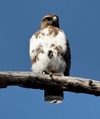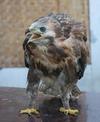Genus Buteo
White-tailed hawk - Averaging 21–23 in in length with a wing span of around 4 ft
White-throated Hawk - The White-throated Hawk is a rather small Buteo, 42 to 45 centimeters long. It lives in the Andes mountains of South America and ranges down to the coast in the O'Higgins region of Chile, preferring wooded areas. It is closely related to the more widely distributed Short-tailed Hawk and was formerly considered conspecific with it. The White-throated Hawk differs in having a longer tail and no dark morph. It also shows plumage differences such as brown streaks on the breast and belly, and a blackish tail with barely visible darker bands.
Band-tailed black hawk - Grown birds are 47–55 cm in length with a wingspan of about 1.2 m ; their average weight is 810 g . Adult plumage is mostly blackish except that the flight feathers are barred with lighter gray and the tail has three or four bands or "zones", white from below and light gray from above, of which the one second from the tip is particularly broad and conspicuous. The cere and legs are yellow. Immatures are similar except for small white spots on the breast and tails with narrow gray and black bands and a broad dark tip. The Zone-tailed Hawk adults resemble the Common Black Hawk but are smaller and have more white bars on the tail.
Augur Buzzard - The Jackal Buzzard is a 55–60 cm long African bird of prey with three main subspecies.
African Red-tailed Buzzard - The Red-necked Buzzard is a species of bird of prey in the Accipitridae family. It is found in Angola, Benin, Burkina Faso, Cameroon, Central African Republic, Chad, Republic of the Congo, Democratic Republic of the Congo, Ivory Coast, Equatorial Guinea, Ethiopia, Gabon, Gambia, Ghana, Guinea, Liberia, Mali, Mauritania, Niger, Nigeria, Senegal, Sierra Leone, Sudan, Togo, and Uganda.
Madagascar Buzzard - Its natural habitats are subtropical or tropical moist lowland forests and subtropical or tropical moist montane forests.
Sooty hawk - The Short-tailed Hawk is an American bird of prey in the family Accipitridae, which also includes the eagles and Old World vultures. As a member of the genus Buteo, it is not a true hawk and thus also referred to as a "buteo" or "buzzard". The White-throated Hawk is a close relative and was formerly included in the species B. brachyurus.
Common Buzzard - The Common Buzzard is a medium to large bird of prey, whose range covers most of Europe and extends into Asia. It is typically between 51–57 cm in length with a 110 to 130 cm wingspan, making it a medium-sized raptor. There are around 40,000 breeding pairs in Britain. It is usually resident all year except in the coldest parts of its range, and in the case of one subspecies.
Galapagos hawk - Similar in size to the Red-tailed Hawk and the Swainson's Hawk of North America, the Galápagos Hawk is about 55 cm from beak to tail with a wingspan of 120 cm. Females are noticeably larger than males as in many species of birds of prey. Mature adults are generally a sooty brownish black with a slightly darker crown. Pale brown, grey, or buff feathers line the edge of the mantle, and the tail is a silvery grey. Their grayish black bill contrasts with a yellow cere, legs and feet. Juveniles are a blackish brown, mottled with buff and white and a black streak extending from the corners of their mouth. Unlike the adults', their bill is blue-grey at the base, their cere a grey-green, and their feet a pale yellow-green. Other than the difference in size, the male and female look quite similar.
Upland Buzzard - It is found in Bhutan, China, Hong Kong, Pakistan, Iran, Japan, Kashmir Kazakhstan, North Korea, South Korea, Mongolia, Nepal, Republic of India, Russia, Tajikistan, and Uzbekistan. Its natural habitat is boreal forests.
Red-tailed Hawk - The Red-tailed Hawk is a bird of prey, one of three species colloquially known in the United States as the "chickenhawk," though it rarely preys on chickens. It breeds throughout most of North America, from western Alaska and northern Canada to as far south as Panama and the West Indies, and is one of the most common buteos in North America. Red-tailed Hawks can acclimate to all the biomes within its range. There are fourteen recognized subspecies, which vary in appearance and range. It is one of the largest members of the genus Buteo in North America, typically weighing from 690 to 1600 grams and measuring 45–65 cm in length, with a wingspan from 110 to 145 cm . The Red-tailed Hawk displays sexual dimorphism in size, with females averaging about 25% heavier than males.
Rough-legged Buzzard - It breeds on cliffs, slopes or in trees, laying about four eggs, but more in good lemming years. It hunts over open land, eating small mammals and carrion. This species, along with the Osprey, is one of the few large birds of prey to hover regularly.
Red-shouldered Hawk - Males are 43 to 58 cm long, weigh about 550 g and have a wingspan of 96 cm . Females are slightly larger at 48 to 61 cm in length, a weight of about 700 g , and a wingspan of about 105 cm . Adults have a brownish head, a reddish chest, and a pale belly with reddish bars. Their tail, which is quite long by Buteo standards, is marked with narrow white bars. The red "shoulder" is visible when the bird is perched as seen in the image to the right. These hawks' upper parts are dark with pale spots and they have long yellow legs. Western birds may appear more red while Florida birds are generally paler. The wings of adults are more heavily barred on the upper side. Juvenile Red-shouldered Hawks are most likely to be confused with juvenile Broad-winged Hawks, but can be distinguished by their long tail, crescent-like wing markings, and a more flapping, Accipiter-like flight style.
Roadside hawk - The Roadside Hawk is a relatively small bird of prey found in Latin America.
Gray Hawk - It breeds from the southwestern United States and Mexico south to Bolivia, Brazil and central Argentina. It is fairly common on Trinidad, and there have been recent sightings on Tobago.
African Mountain Buzzard - At 45-50 cm, it is smaller than the Steppe Buzzard and darker brown, with less rufous above.
Broad-winged Hawk - Adult birds range in size from 34 to 45 cm , weigh from 265 to 560 g and have a wingspan from 81 to 100 cm . As in most raptors, females are slightly larger than males. Adults have dark brown upper parts and evenly spaced black and white bands on the tail. Light morphs are pale on the underparts and underwing and have thick cinnamon bars across the belly. The light morph is most likely to be confused with the Red-shouldered Hawk, but that species has a longer, more heavily barred tail and the barred wings and solid rufous color of adult Red-shoulders are usually distinctive. Dark morphs are a darker brown on both upperparts and underparts. They are much less common than the light-coloured variant. Dark-morph Short-tailed Hawks are similar but are whitish under the tail with a single subterminal band. Broad-winged Hawks' wings are relatively short and broad with a tapered, somewhat pointed appearance unique to this species.
Variable Hawk - The Variable Hawk is a polymorphic species of bird of prey in the Accipitridae family. It is widespread and often common in open habitats in western and southern South America, including the Falkland Islands. Its taxonomy is disputed, with some splitting it into the widespread Red-backed Hawk and the Puna Hawk of the central and north Andean highlands, but the differences between the two are unclear, and consequently recent authorities have recommended treating them as a single species.
Ferruginous hawk - This species is a large, long-winged hawk of the open, arid grasslands, prairie and shrub steppe country; it is endemic to the interior parts of North America. It is used as a falconry bird in its native range.
Ridgway's Hawk - The Ridgway's Hawk's original breeding range included Haiti and the Dominican Republic and some of the adjacent isles and keys. As of 2006, its only known population resides within Los Haitises National Park in the northeastern Dominican Republic, which is mostly covered by wet limestone forest.
Long-legged Buzzard - It is similar in appearance to the Rough-legged Buzzard , but larger and more robust. There are many different colour forms, but usually Long-leggeds have a clear orange tint to the plumage, red or orange tail, pale head and largely white underwings. There is usually a distinctive black carpal patch and dark trailing edge to the wing. The rump and "trousers" are often dark or deep rufous. Plumage varies from ghostly pale individuals to very dark ones. Some plumages are almost similar to those of the Steppe Buzzard, the eastern subspecies of the Common Buzzard , but Long-legged Buzzards have longer wings and are more like Rough-Legged buzzards or even a small Aquila eagle.
Jackal Buzzard - The Jackal Buzzard is a 55–60 cm long African bird of prey with three main subspecies.
Gruber's hawk - The Hawaiian Hawk measures approximately 40 to 46 centimetres in length. The female is larger than the male. Two color phases exist: a dark phase , and a light color phase . Feet and legs are yellowish in adults and greenish in juveniles.
Swainson's Buzzard - The Swainson's Hawk , is a large buteo hawk of the Falconiformes, sometimes separated in the Accipitriformes like its relatives. This species was named after William Swainson, a British naturalist. It is colloquially known as Grasshopper Hawk or Locust Hawk, as it is very fond of Acrididae and will voraciously eat these insects whenever they are available.
Rufous-tailed Hawk - The Rufous-tailed Hawk is found in southern Argentina and Chile, including the entire region of Tierra del Fuego.

















